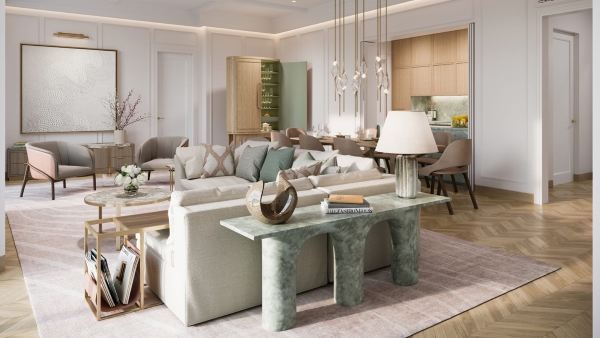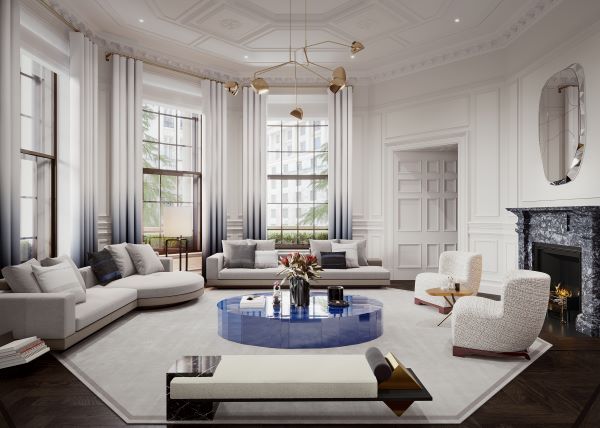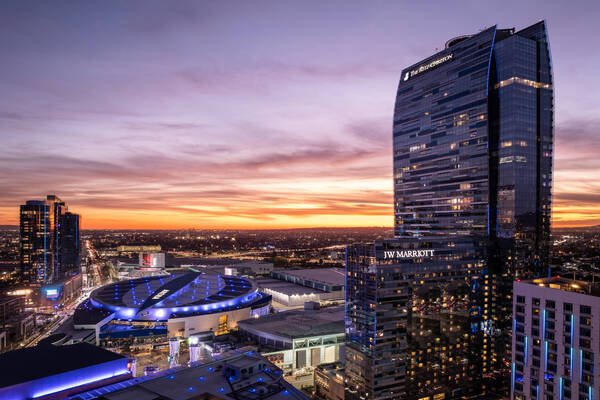Live, work, play has become a credo for a growing real estate portfolio where residents can combine their homes, employment and diversions in one compact setting. Mixed-use developments that include hotels are not a new idea, but they do fit synergistically into that environment. And heightening that trend is the rise of branded hotel residences as core to the concept.
There is general agreement that mixed-use with hotels is a fit for the current financial landscape. As Ophelia Makis, senior research analyst, JLL Hotels and retail capital markets, said, “The recognition of mixed-use as an asset class is driving heightened interest, particularly due to the growing popularity of live, work, and play consumer trends.”
In today’s economic environment, said Kara Randall, VP and managing director, luxury and mixed-use development at Hilton, ground-up deals frequently require a residential component to get completed, due to current capital markets, rising construction costs and interest rates. “I’ve been doing this for nearly 20 years and in the past not seen many projects seeking branded residences,” Randall said. “It is now much more prevalent. All our luxury brands have this option and Hilton has an emphasis on growing this segment.”
There are still instances of a deal with only a hotel, said Randall, but that is becoming less common in the luxury space. With a midscale or upscale hotel, she said, it’s easier to finance a project without residences.
No different, Marriott International continues to see strong interest in these ventures, from both developers and customers, said Dana Jacobsohn, chief development officer, North America, luxury and global mixed-use. With that heightened demand, she said, many pipeline projects include a residential component. About two-thirds of the company’s luxury residential pipeline is co-located to a hotel.
Mixed-use with hotels is not new. Four Seasons has been involved with projects that include a traditional hotel with residential since 1985, noted Chris Meredith, group head of residential, Four Seasons Hotels & Resorts. Since then, the company’s Private Residences have been a key pillar, today operating 54 locations around the world with 65% of the upcoming hotel and resort pipeline including a residential component.
Accor, which has tentacles in myriad avenues of hospitality, is active in this segment, too. Jeff Tisdall, chief business officer, Accor One Living, and global head of mixed-use, said Fairmont Hotels and Resorts helped pioneer the category of branded residences beginning in the early 2000s, with mixed-use becoming an increasingly important part of the brand’s growth strategy since.
Accor One Living, a 360-degree platform supporting the initiation, design and operation of mixed-use complexes, now serves more than 7,000 homeowners at nearly 50 locations, including many Fairmont communities, with more than 110 projects underway.
The spectrum of possibilities only continues to widen, said Tisdall. The portfolio, he said, includes not only established luxury pioneers in branded residential, such as Fairmont and Raffles, but also lifestyle brands from its joint venture with Ennismore, such as SLS, SO/ and Mama Shelter. A recent example is SO/Uptown Dubai, said Tisdall, where fashion and “design theater” inspire a “spectacular” set of amenities and private facilities that are exclusive to residence owners.

RETAIL THERAPY
JLL’s perception of mixed-use has evolved from previous decades, said Makis. It now extends beyond the concept of incorporating at least two different property types. Instead, the consultancy views mixed-use as a distinct asset class, where the focus lies not only on the presence of multiple components, but also seamlessly integrating them cohesively with flagship or experiential retail, apartments or branded residences, an office park or a lifestyle hotel.
There is evolution on the retail component of mixed-use, as well, said Makis. The traditional placement of retail solely on the ground floor is evolving, she said, as owners and developers adopt a more strategic approach to activating available retail spaces. These include offering food-and beverage delivery services, fitness and spa facilities and unique shopping experiences to hotel guests and full-time residents.
This trend is particularly pronounced in luxury, lifestyle mixed-use, said Makis, as branded residences seek to collaborate with brands to provide high-end experiences. She cited the Asbury Ocean Club on the New Jersey Shore, which features a cinema room, chef’s kitchen, art gallery, spa, fitness center and a retreat called The Drawing Room encompassing a bar and music room.
Branded residences aren’t a magic pill for mixed-use. As Makis said, “It’s crucial to acknowledge the challenging landscape in terms of development.” As mixed-use projects thrive on scale, she said, they encompass significant space requirements and demand substantial capital investment. Further, said Makis, as with the broader construction industry, disruptions in areas, such as construction hiring, material costs, backlogs and financing, are limiting the pace of new mixed-use construction.

THE BRANDS BENEFIT
There are many reasons why mixed-use developers seek out well-known hotel brands to partner with on branded residences. They often utilize a condo component to offset their basis in a project, said Randall. Some local jurisdictions allow condo deposits from purchasers to be used for initial project equity. In addition, having a recognized brand helps developers capitalize their projects. Randall noted that a hotel brand brings a market premium on unit sales, which is generally accepted as ranging from 20% to 30% above what the value would be on an otherwise unbranded project.
Hilton, said Randall, also brings a booking engine, expertise, service standards and a pipeline of customers. Beyond that, the company can provide a wide range of skills developers can choose from: handling HOA management, concierge services, 24/7 security, package receiving, in-room dining, signing privileges with the hotel, engineering, pet and auto services and more.
In addition, branded residence buyers receive Hilton Honors Diamond status, as well as dedicated owner concierges for the length of their ownership.
If a development can offer a hotel with an elevated guest experience beyond the physical restaurant space and basic amenities, said Makis, it will create an atmosphere of exclusive membership that will draw increased demand. This is particularly true with upper upscale and luxury hotels in the lifestyle category, which have become popular meeting destinations. As a result of the extra layer of exclusivity and uniqueness in the overall hotel and mixed-use experience, these hotels, said Makis, achieve a higher ADR relative to the same class of hotels within their submarket.
A case study conducted by JLL in 2023 revealed that a sample of luxury and upper upscale hotels in mixed-used developments commanded an average rate premium of 27%, resulting in a 21% higher RevPAR index.
Owners, said Jacobsohn, get the benefit of both the hotel and their residential facilities. For example, Marriott’s recently opened 9,000th property, The St. Regis Longboat Key Resort and Residences in Florida, offers guests and residents a 20,000-square-foot spa, an oceanfront relaxation room, steam and sauna areas, thermal experiences, beauty salon and 14 treatment rooms.
Accor curates unique programming, services and experiences at each residential project, said Tisdall, whether it’s hosting an intimate talk with an author or artist in a screening room, creating cocktail or wine tasting events or supporting the design and activating a private dining concept. The OWO Residences by Raffles in London, for example, offers a dedicated concierge team with fitness and wellness attendants, dog-walking and sommelier services, private chefs and butler services.

Hospitality brands, said Tisdall, can help residential developers accelerate sales and can significantly enhance economic viability. Industry experts, such as Savills Global Residential Development Consultancy, he said, have consistently found the average premium captured by developers’ licensing global brands for their private residence projects to exceed 30%. Generally, integrating components of mixed-use components, sharing amenities, facilities and services, enhances the economics and performance of those investments.
Because the financing environment remains challenging, especially for new-builds, said Jacobsohn, many developers have found that mixed-use projects and Marriott Branded Residences can provide added cost benefits while helping to diversify their portfolios.
Conversely, hotel operators are looking to mixed-use to drive revenues otherwise unavailable in a more traditional project. Non-hotel guests, said Makis, create a strong demand driver, as many mixed-use developments, particularly horizontal ones, become “placemaking” communities within the market, which allows the hotel to increase non-rooms revenue. Examples of this, she said, include the Equinox Hotel in Hudson Yards in Manhattan and the Tampa Edition at Water Street, a “wellness community” with dining, entertainment and more.
As the market for branded residences continues to accelerate, said Tisdall, “It is valuable to emphasize that selecting the right hospitality brand and taking a consumer-centric approach is essential to successful projects.”
Story contributed by Harvey Chipkin.






